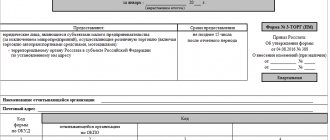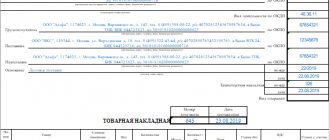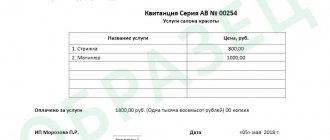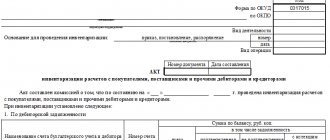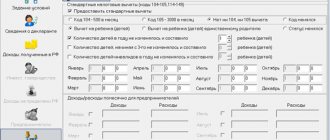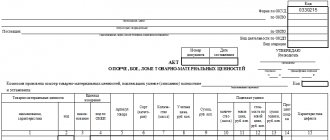1-TORG - report for trade organizations
The Federal State Statistics Service expects Form 1-TORG from legal entities engaged in wholesale trade, retail trade, as well as wholesale and retail trade in motor vehicles and motorcycles. That is, the respondents are organizations with an OKVED code from classes 45, 46 and 47.
Important! Organizations with OKVED codes 45.2 and 45.40.5 submit the form only if they are car dealers - they retail new and used cars, motorcycles, parts and accessories.
Small businesses are exempt from submitting a report. These are companies whose income does not exceed 800 million rubles per year, and the average number of employees is 100 people.
On a general basis, those who did not conduct business for part of the reporting period also submit the form of organization in the bankruptcy process.
Features of working with TORG-1
The organization draws up an act when it receives goods from the supplier. If there are discrepancies in quality and/or quantity in some items of the cargo, or if the goods and materials arrived at the organization without the supplier’s documents, then in the first case the TORG-2 and TORG-3 forms are used, and in the second - TORG-4.
The purpose of the goods acceptance certificate is to confirm the receipt of goods received at the warehouse. The document can also serve as the basis for writing a complaint to the supplier or seller.
The algorithm for receiving goods is as follows:
- the employee receiving the goods compares the actual availability with what is indicated in the accompanying documents, fills out a report in the TORG-1 form;
- if discrepancies are found, then it is necessary to suspend the acceptance procedure and ensure the safety of the goods and prevent their mixing with similar goods;
- you need to call a representative of the supplier company;
- draw up a special act, which records the reasons and duration of interruptions in the receipt of products.
Attention! Acceptance of goods must be stopped if the packaging of goods is damaged, a discrepancy in labeling, quantity, or expiration date is detected.
The form is filled out by a special commission, which is formed by order of the head of the organization. Usually it consists of 3 people.
The number of document copies is selected depending on the document flow conditions in the organization. The completed act must be submitted to the accounting department.
Deadlines and procedure for submitting form 1-TORG
Respondents submit the form once a year. Until February 17 after the reporting period. If this day falls on a weekend, the form can be turned in on the next working day. For example, if February 17th falls on a Saturday, the form can be turned in on Monday, February 19th.
The form is filled out by legal entity, taking into account all separate divisions located with it in the same entity. If the unit is located in another region, a separate report must be prepared and submitted for it.
Structure of form 1-TORG
Form 1-TORG was approved by Rosstat order No. 418 dated July 22, 2019 in Appendix No. 1 OKUD code 0614004. The latest version of the order came into force on July 16, 2020 and will be relevant for the 2020 report. The same order contains a list of respondents, the order of submission and instructions for filling out the form.
The form contains a title page and five sections:
- Section 1 - for wholesale and retail organizations that trade in bulk. The section shows how many and what goods in thousands of rubles were sold wholesale during the year;
- section 2 - for wholesale and retail organizations that trade in retail. The section is filled out in the same way as the first. Subsection 2.1 is intended for gas stations;
- section 3 - for wholesale and retail organizations. Wholesale and retail turnover is distributed by month of the reporting year in thousands of rubles. Separately, it is necessary to highlight the wholesale turnover under commission, commission and agency agreements;
- section 4 - for retail organizations that sell in various municipalities. It is necessary to show the general trade turnover, food products and tobacco products;
- Section 5 - filled out by organizations that trade wholesale and retail and have warehouse network facilities. The section needs to show data about objects of each category.
About the TORG-1 form
The form was introduced by Decree of the State Statistics Committee of December 25, 1998 No. 132. Since the beginning of 2013, it has ceased to be mandatory for use in accordance with Federal Law No. 402-FZ (“On Accounting”) of December 6, 2011. Companies can themselves develop some forms of primary accounting documents to suit their needs, for example, by changing the forms proposed by law.
Important! The company must specify which forms it will work with in its accounting policies. For this purpose, the manager issues an appropriate order.
If you decide to choose independently developed forms, then you need to keep in mind that they must have a number of mandatory details of the primary accounting document in order to be considered valid. The list is specified in paragraph 2 of Art. 9 Federal Law No. 402-FZ.
The TORG-1 form is chosen by many companies because it contains all the necessary information and is familiar to inspection agencies. This is important, since the document is used to confirm the validity of the VAT deduction.
How to fill out form 1-TORG
Let's look at the procedure for filling out each section of the report.
Title page
Indicate the reporting year, full and abbreviated name of the organization, as given in the constituent documents. In the “Postal Address” line, write down the zip code, subject of the Russian Federation, city, street, house and office. If the actual address of business differs from the legal address, indicate it.
Section 1
Section 1 is fairly easy to complete. Line 01 is the result line. It shows the total turnover of wholesale trade, that is, revenue from the sale of goods that were purchased specifically for resale.
Next, line 01 needs to be distributed among product groups. You don’t have to fill out all the lines; focus only on the types of products you need. To make it easier to find the required groups, OKPD2 codes are given in column 2.
Wholesale trade can be distinguished by the presence of an invoice for shipment. Show in the section turnover in actual sales prices - thousand rubles with one decimal place. Do not exclude markups, VAT, excise taxes, duties, fees, etc.
Section 2
Fill out the second section in the same way as the first. The difference is that it is designed for retail sales reporting.
Line 01 is the result, which is further expanded and specified in detail. The first line includes the entire retail trade turnover - this is revenue from the sale of goods to the public for personal consumption or household use. This also includes the sale of goods of own production through retail establishments.
The main sign of retail transactions is a cash receipt or another document that can replace it. Sales of goods to legal entities, individual entrepreneurs and public catering turnover do not fall under Section 2.
Include data at full cost in the report, even if the product was sold at a discount, on credit or at the expense of social security authorities.
Subsection 2.1 is provided for gas stations. In it, show data on the number of gas stations. And separately count how many multi-fuel and gas stations you have. This section includes gas stations owned and leased. Do not count rental properties.
Section 3
The third section is needed to distribute turnover by month. Columns 3 and 4 show wholesale turnover, and column 5 shows retail turnover. Indicate the turnover in thousand rubles with one decimal place.
In the text part it is necessary to provide additional explanations on retail trade. Line 14 shows the volume of sales based on citizen orders collected through TV, radio, telephone or the Internet, as well as sales through vending machines and agents with door-to-door delivery.
In line 15 - show the volume of sales through e-commerce, as a rule, these are online stores.
Line 16 shows the turnover of sales by mail. For example, when the buyer chose a product based on an advertisement, catalog, sample, etc. If you sold goods on credit, indicate their full cost on line 17.
Line 18 is needed for those who sell retail using a car: vans, trailers, tanks, tonars, auto shops, store wagons and ships.
Section 4
In the fourth section, report on retail trade by municipality. In column 1, enter the names of the MO in which you sell the goods, in column 2 - OKTMO code, and in columns 3, 4 and 5 - the cost of goods sold in thousand rubles with one decimal place. Column 3 is for general turnover, 4 - products, drinks and tobacco, 5 - only for tobacco products.
This section is completed differently for paper and electronic reports. In paper column 2 you do not need to fill in, but in electronic form you need to fill in column 2, but do not fill out column 1.
Section 5
As of January 1, 2021, show information about the warehouse network facilities used. The lines are filled in by the owners of warehouses (including leased warehouses or individual premises in them), as well as warehouse tenants who are trading organizations.
Indicate the number of warehouses, and from them, select those that are suitable for storing potatoes and fruits and vegetables. In line 03, calculate the warehouse area, in line 04 - the warehouse volume (area × height). For line 06, calculate how many tons of potatoes and other fruits and vegetables you store at a time.
Form 1-TORG
Sample filling 1-TORG
Check the finished report against the control ratios given in the instructions for completion, and sign in the prescribed manner.
Legislative framework of the Russian Federation
not valid Edition from 06.06.2007
detailed information
| Name of document | DECREE of Rosstat dated 06.06.2007 N 45 “ON APPROVAL OF STATISTICAL INSTRUMENTS FOR ORGANIZING STATISTICAL OBSERVATION OF DOMESTIC AND FOREIGN TRADE FOR 2008” |
| Document type | decree, order |
| Receiving authority | Rosstat |
| Document Number | 45 |
| Acceptance date | 01.01.1970 |
| Revision date | 06.06.2007 |
| Date of registration with the Ministry of Justice | 01.01.1970 |
| Status | It does not work |
| Publication |
|
| Navigator | Notes |
DECREE of Rosstat dated 06.06.2007 N 45 “ON APPROVAL OF STATISTICAL INSTRUMENTS FOR ORGANIZING STATISTICAL OBSERVATION OF DOMESTIC AND FOREIGN TRADE FOR 2008”
The procedure for filling out and submitting form N 1-TORG
1. Form N 1-TORG is submitted by all legal entities whose main activity is wholesale or retail trade (except for small businesses) of all forms of ownership, and their separate divisions. Organizations whose main activity is the maintenance and repair of motor vehicles and motorcycles (OKVED codes 50.2, 50.40.4), as well as the repair of household products and personal items (OKVED code 52.7) in form N 1-TORG “Information on sales and inventories of goods in wholesale and retail trade organizations” are not reported.
The address part of the form indicates the full name of the reporting organization in accordance with the constituent documents registered in the prescribed manner, and then the short name in brackets.
The line “Postal address” indicates the name of the subject of the Russian Federation, legal address with postal code.
In the code part, the code of the All-Russian Classifier of Enterprises and Organizations (OKPO) must be entered on the basis of the Notification of assignment of the OKPO code sent (issued) to organizations by state statistics bodies.
2. In Form N 1-TORG, information is provided by a legal entity in total for all its divisions (including branches), except for territorially separate divisions located on the territory of other constituent entities of the Russian Federation (republics, territories, regions). Geographically separate divisions located on the territory of other constituent entities of the Russian Federation submit data to the statistical authorities at their location. If separate divisions (branches, representative offices) do not have information to fill out the form, then information for each such separate division is filled out on a separate form by the parent organization and sent to these separate divisions (branches, representative offices) for subsequent submission to the state statistics authorities. their location within the established time limits.
Legal entities submit Form N 1-TORG, as a rule, at the place of their state registration. An exception to this rule are cases when a legal entity registered on the territory of a constituent entity of the Russian Federation does not carry out activities on the territory of this constituent entity of the Russian Federation. In this case, the specified form is submitted at the place of actual trading activities.
3. In the case of carrying out activities on the basis of a simple partnership agreement (joint activity agreement), the cost of goods sold by the partners as a result of their joint activities, when each partner fills out form N 1-TORG, is distributed among the partners in proportion to the value of their contributions to the common cause, unless otherwise provided by the simple partnership agreement or other agreement of the partners. If the cost of these goods cannot be distributed among partners, then information on them is shown on a separate form of state statistical observation by the partner who is entrusted with keeping records of common property.
4. Wholesale trade organizations (committors, principals, principals) selling goods under a commission agreement, commission or agency agreement, i.e. transferring goods to another organization or individual entrepreneur (commission agent, attorney or agent) for resale to legal entities and individual entrepreneurs, reflect the sales volumes and balances of these goods in Section 1 “Sales to inventories of goods (products) by type” in columns 6, 7 and 8 and in section 2 “Turnover of wholesale and retail trade by months of the reporting year” on line 155. Commission agents (attorneys, agents) carrying out transactions in wholesale trade fill out only section 2, where lines 155 and 156 reflect the amount of remuneration (in this case p. 155 = p. 156).
Organizations carrying out transactions in retail trade in the interests of another person on the basis of commission agreements, commissions or agency agreements, fill out sections 1 and 2. The cost of goods sold to the public by commission agents (attorneys, agents) is reflected in section 1, columns 9 and 10 and in section 2 lines 157 - 162; The principals (principals, principals) who are the owners of these goods do not reflect the proceeds from their sale (retail trade turnover) in form N 1-TORG, since this information is filled in by the organization (usually a commission agent) that directly sells goods to the public.
5. Section 1 “Sales and inventories of goods (products) by type” in terms of wholesale trade (columns 6 - also filled in by retail trade organizations if they carried out wholesale sales of goods in the reporting year. Similarly, wholesale trade organizations that carried out sales in the reporting year goods to the population, fill out columns 9 - 10.
also filled in by retail trade organizations if they carried out wholesale sales of goods in the reporting year. Similarly, wholesale trade organizations that carried out sales in the reporting year goods to the population, fill out columns 9 - 10.
6. Line 01, column 7 shows wholesale trade turnover, which represents revenue from the sale of goods previously purchased externally for the purpose of resale to legal entities and individual entrepreneurs for professional use (for processing or further sale). Wholesale trade turnover also includes the amount of remuneration of wholesale trade intermediaries, i.e. commission agents (attorneys, agents) carrying out transactions for the purchase and sale of goods on behalf of or at the expense of other persons or firms (principals, principals, principals) under commission (assignment) agreements or agency agreements, but this amount is not reflected on line 1 of section 1 , but is shown on line 156 of section 2 and is included in the data on line 155 of section 2.
Wholesale trade turnover is indicated in actual sales prices, including trade margins, value added tax, excise duty, export duty, customs duties and similar mandatory payments. A mandatory feature of an operation classified as wholesale trade is the presence of an invoice for the shipment of goods.
Data on sales and inventories of own-produced products in columns 6, 7 and 8 are not shown.
7. Columns 6 and 7 provide information on wholesale sales by product groups and individual types of goods, respectively, in physical and value terms.
The data in column 7, line 01 must be equal to the sum of lines 02 and 59 in this column.
The data in column 7, line 02 must be equal to the sum of lines 03, 08 - 10, 12 - 17, 19, 20, 24, 27, 30 - 45, 52, 53.
The data in column 7, line 59 should be equal to the sum of lines 60 - 88, 92 - 98, 100 - 105, 107, 108, 110 - 113, 116 - 120, 125 - 127, 129 - 143, 145, 148, 149.
Please note that the data on line 106 “Window glass (sheet)” in columns 6 and 8 is given in thousand m2, and on line 146 “Cement” in columns 6 and 8 - in tons.
Data expressed in pieces, deciliters, kilograms, conventional boxes, cubic meters, dense cubic meters are given in whole numbers.
Data expressed in thousands of rubles, tons, thousands of tons, thousands of pieces, thousands of standard cans, thousands of decalitres, thousands of linear meters, thousands of pairs, thousands of square meters, millions of cubic meters are given with one decimal place.
8. Column 8 shows data on inventories of goods at the end of the year purchased externally and intended for resale to legal entities or individual entrepreneurs. Information on inventories in wholesale trade is given in the units of measurement indicated in column 4. For lines with the unit of measurement in thousands of rubles, inventories are reflected at purchase prices (excluding VAT and excise tax). Data on inventories of goods are provided for all storage locations (warehouses, cold storage warehouses, warehouses, etc.), including rented ones. This column also reflects inventories of goods transferred by the reporting organization for safekeeping. Goods accepted for safekeeping or located in leased areas and owned by other organizations are not shown in column 8. Data on inventories of goods of own production in column 8 is also not shown.
9. Line 01, Column 9 shows retail trade turnover (excluding public catering turnover), which represents revenue from the sale of goods to the public for personal consumption or household use in cash or paid by credit cards, bank checks, transfers from depositors' accounts via payment cards, which is also counted as cash sales. The cost of goods sold to the population at a discount (fuel, etc.), on credit, by mail and by sample, as well as the cost of medicines dispensed to certain categories of citizens free of charge or with preferential prescriptions, is included in retail trade turnover at the full cost.
The cost of goods sold through the retail trade network to legal entities (including social organizations, special consumers, etc.) and individual entrepreneurs is not included in retail trade turnover.
A mandatory feature of a transaction classified as retail trade is the presence of a cash receipt (invoice) or other document replacing the receipt.
The cost of goods sold to the population is given in retail prices - actual selling prices, including trade margins, value added tax and similar mandatory payments.
10. Column 9 provides information on retail sales by product groups (goods) in value terms.
The data in column 9, line 01 must be equal to the sum of lines 02 and 59 in this column.
The data in column 9, line 02 must be equal to the sum of lines 03, 08 - 10, 12 - 17, 19, 20, 24, 27, 30 - 45, 52, 53.
The data in column 9, line 59 must be equal to the sum of lines 60 - 88, 92 - 98, 100 - 105, 107, 108, 110 - 113, 116, 125 - 127, 129, 132, 133, 136, 145, 148, 149 .
11. Column 10 shows information about inventories of goods in retail trade at the end of the year. Inventories are reflected at sales prices, including trade margins and VAT. Data on inventories of goods by retail trade organizations are provided for all places where goods are stored (warehouses, refrigerated warehouses, stores), including rented ones. Wholesale trade organizations engaged in retail trade, in column 10, show inventories of goods intended for sale to the public directly by this organization. Goods accepted from the public on commission are not included in the volume of inventory in retail trade.
12. Information on the sale and inventory of goods not listed in column 1, but occupying more than 10% of the total sales volume, is reflected on free lines. Lines 54 - 58 show information about goods that occupy the largest share in other food products (line 53), and lines 150 - 154 - respectively, in non-food products (line 149).
13. Section 2 “Wholesale and retail trade turnover by month of the reporting year” provides information on wholesale trade turnover on line 155 and on retail trade turnover on line 157, broken down by month of the reporting year.
The data on line 155 minus the data on line 156, column 3 of section 2 “Wholesale and retail trade turnover by month of the reporting year” should be equal to the data on line 01, column 7 of section 1 “Sales and inventories of goods (products) by type.”
The data on line 157, column 3 of section 2 “Wholesale and retail trade turnover by month of the reporting year” must be equal to the data on line 01, column 9 of section 1 “Sales and inventories of goods (products) by type.”
14. Line 158 in Section 2 provides data on the cost of goods sold on credit (at the time the goods are released to the buyer), in the amount of the full cost of the goods.
15. Line 159 provides data on the volume of sales of goods by order of the population by mail, through television and online stores, as well as in kiosks, tents, through auto stores, auto shops, etc.
16. Line 162 indicates the cost of goods sold in rural areas (revenue from the sale of goods in rural stores, tents, kiosks, as well as revenue from outbound trade in rural areas, through auto stores, vans, auto shops).
17. In the “For reference” section, line 163 shows revenue from the sale of products and goods, receipts associated with the performance of work and provision of services, business transactions, which are income from ordinary activities. The data on line 163 must correspond to the indicator “Revenue (net) from the sale of goods, products, works, services (minus value added tax, excise taxes and similar mandatory payments)” of Form No. 2 “Profit and Loss Statement” and a similar indicator of the form Federal State Statistical Observation No. P-3 “Information on the financial condition of the organization.” Columns 4, 5 and 6 on line 163 provide data on revenue received as a result of wholesale trade, retail trade and other activities, respectively. On line 163, the data in column 3 must be equal to the sum of the data in columns 4, 5 and 6.
Organizations (commission agents, attorneys, agents) carrying out trading activities in the interests of another person under commission, commission or agency agreements indicate the cost of services in the amount of remuneration.
Line 164 from line 163 shows the amount of remuneration for the provision of intermediary services for the sale of goods accepted on commission to the public.
Line 165 reflects the recorded costs for the production of goods, products, works, services in the share related to the goods, products, works, services sold. When carrying out trading activities, line 165 reflects the purchase price of goods, the proceeds from the sale of which are reflected in line 163.
The data on line 165 must correspond to the indicator “Cost of goods sold, products, works, services” of form N 2 “Profit and Loss Statement” and a similar indicator of the federal state statistical observation form N P-3 “Information on the financial condition of the organization”. On line 165, the data in column 3 must be equal to the sum of the data in columns 4, 5 and 6.
How to fill out 1-TORG through Kontur.Extern
The form can be submitted in paper or electronic form. To avoid visiting the department and standing in line at the post office, use the electronic format.
Kontur.Extern helps you submit reports to the tax office, funds and Rosstat without leaving your work computer and without additional agreement with the authorities. You just need to register and issue an electronic signature.
To send 1-TORG via Extern, go to the “Rosstat” section, select the desired report and fill out the form according to the instructions provided. Fields with information known to the service will be filled in automatically.
Before submission, the form will be checked against approved control ratios. Errors detected by the program can be corrected in editing mode. Finally, sign the electronic signature report and submit it. You will receive confirmation from Rosstat that the form has been accepted.
